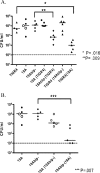The blp bacteriocins of Streptococcus pneumoniae mediate intraspecies competition both in vitro and in vivo
- PMID: 17074857
- PMCID: PMC1828380
- DOI: 10.1128/IAI.01775-05
The blp bacteriocins of Streptococcus pneumoniae mediate intraspecies competition both in vitro and in vivo
Abstract
The introduction of the conjugate seven-valent pneumococcal vaccine has led to the replacement of vaccine serotypes with nonvaccine serotypes of Streptococcus pneumoniae. This observation implies that intraspecies competition between pneumococci occurs during nasopharyngeal colonization, allowing one strain or set of strains to predominate over others. We investigated the contribution of the blp locus, encoding putative bacteriocins and cognate immunity peptides, to intraspecies competition. We sequenced the relevant regions of the blp locus of a type 6A strain able to inhibit the growth of the type 4 strain, TIGR4, in vitro. Using deletional analysis, we confirmed that inhibitory activity is regulated by the function of the response regulator, BlpR, and requires the two putative bacteriocin genes blpM and blpN. Comparison of the TIGR4 BlpM and -N amino acid sequences demonstrated that only five amino acid differences were sufficient to target the heterologous strain. Analysis of a number of clinical isolates suggested that the BlpMN bacteriocins divide into two families. A mutant in the blpMN operon created in the clinically relevant type 19A background was deficient in both bacteriocin activity and immunity. This strain was unable to compete with both its parent strain and a serotype 4 isolate during cocolonization in the mouse nasopharynx, suggesting that the locus is functional in vivo and confirming its role in promoting intraspecies competition.
Figures




References
-
- Aniansson, G., B. Alm, B. Andersson, P. Larsson, O. Nylen, H. Peterson, P. Rigner, M. Svanborg, and C. Svanborg. 1992. Nasopharyngeal colonization during the first year of life. J. Infect. Dis. 165(Suppl. 1):S38-S42. - PubMed
-
- Bakir, M., A. Yagci, N. Ulger, C. Akbenlioglu, A. Ilki, and G. Soyletir. 2001. Asymptomatic carriage of Neisseria meningitidis and Neisseria lactamica in relation to Streptococcus pneumoniae and Haemophilus influenzae colonization in healthy children: apropos of 1400 children sampled. Eur. J. Epidemiol. 17:1015-1018. - PubMed
-
- Eijsink, V. G., L. Axelsson, D. B. Diep, L. S. Havarstein, H. Holo, and I. F. Nes. 2002. Production of class II bacteriocins by lactic acid bacteria; an example of biological warfare and communication. Antonie Leeuwenhoek 81:639-654. - PubMed
-
- Garcia-Rodriguez, J. A., and M. J. Fresnadillo Martinez. 2002. Dynamics of nasopharyngeal colonization by potential respiratory pathogens. J. Antimicrob. Chemother. 50(Suppl. 2):59-73. - PubMed
Publication types
MeSH terms
Substances
Associated data
- Actions
- Actions
- Actions
- Actions
- Actions
- Actions
- Actions
- Actions
Grants and funding
LinkOut - more resources
Full Text Sources
Other Literature Sources
Molecular Biology Databases

